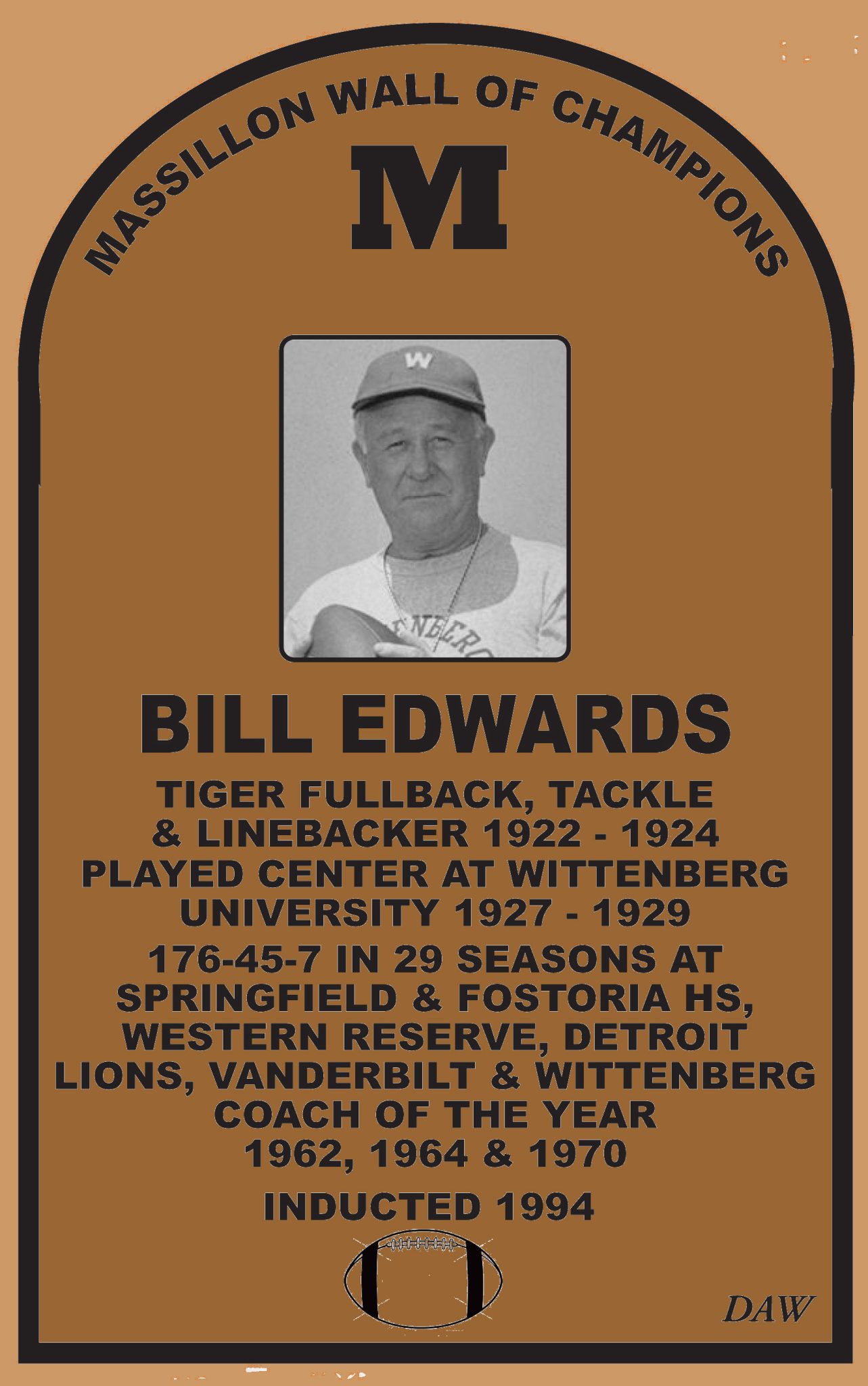
Part 5 – Running Backs in the Massillon Tiger…
Part 5 – Running Backs in the Massillon Tiger Football Hall of Fame – The Later Years
The Tiger Football Hall of Fame recognizes those individuals that have made outstanding contributions to the Tiger football program, whether it be a player, coach, band director or just an individual who has been influential in a positive way. Inductees are honored in the WHS Sports Hall with plaques that display the inductees’ contributions. As of 2022, a total of 105 members have been inducted. Five more will be inducted this year.
Complete List of Massillon Tiger Football Hall of Fame Inductees
This entry is Part 5 of a series that presents past inductees by playing position. This edition features running backs that competed from the 1970s to the present. Seven running backs have gained distinction during this period, including Mike Mauger, Willie Spencer Sr., Tom Hannon, Jerome Myricks, Travis McGuire, Falando Ashcraft and Brian Gamble. There are a few other running backs in the Hall that are not presented in this story, as these players were inducted either through another playing position or as a coach.
Mike Mauger (1968-70)
Mike Mauger joined the varsity team in 1969 as a starter at the defensive end position, playing under Head Coach Bob Commings. But he also saw some time as a substitute running back for the 7-2-1 Tigers, rushing 27 times for 209 yards and scoring 35 points. But what jumped off the page was his average of 7.7 yards per carry. He was also extremely adept at seeing the field and following his blockers.
 It was a natural then that he move into the starting tailback spot during his senior year, playing at 5’-11”, 196 lbs. And what year it was. Massillon finished 10-0 and was voted the state champion, the Tigers’ last state title. Mauger spearheaded the offense, carrying the ball 159 times for 1,200 yards at an average of 7.5 yards per attempt. He also scored 23 touchdowns (5th all-time) and 152 points (4th all-time). For his play he was named 1st Team All-Ohio and Class AAA Back of the Year.
It was a natural then that he move into the starting tailback spot during his senior year, playing at 5’-11”, 196 lbs. And what year it was. Massillon finished 10-0 and was voted the state champion, the Tigers’ last state title. Mauger spearheaded the offense, carrying the ball 159 times for 1,200 yards at an average of 7.5 yards per attempt. He also scored 23 touchdowns (5th all-time) and 152 points (4th all-time). For his play he was named 1st Team All-Ohio and Class AAA Back of the Year.
Mauger’s most memorable games were as follows:
- Trotwood Madison – 3 touchdowns, including an 80-yard punt return.
- Cleveland Benedictine (9-1) – 4 touchdowns, including a 70-yard punt return; 11 carries for 220 yards, at an average of 20.0 yards per carry (1st all-time); 32-7 victory.
- Alliance – 4 touchdowns; 22 carries for 138 yards.
- Niles (7-2-1) – A pivotal game vs. the unbeaten Red Dragons; played injured; rushed 14 times for 138 yards; 22-3 victory.
- Akron St. Vincent – 4 touchdowns.
- Canton McKinley (8-1-1) – The Bulldogs were No. 3 in the state and unbeaten with a tie vs. Niles; scored 2 touchdowns of 4 and 3 yards; 27 carries for 137 yards; 28-0 victory.
Mike also punted 17 times for a 37.3 average. And he returned ten punts, averaging 28.4 yards per return. His two punt returns for touchdown ranks 3rd all-time.
Following high school, Mauger first played for Wisconsin and then finished his eligibility at Kent State University. Post-college he had a tryout with the Dallas Cowboys.
Willie Spencer, Sr. (1969-71)
Willie Spencer was next in line as one of the great Massillon running backs. Ironically, he only played the position one year. But he was good enough to jump right from high school into the professional ranks. He was an imposing figure at that time for a high school running back, playing at 6’-2”, 215 lbs., and with his size and strength could simply run over defenders.
 During his 1970 junior year he lined up at tight end for the 10-0 state champions. There, he was used primarily as a blocker, but he did catch five passes for 75 yards, including a 9-yard touchdown reception against Alliance. He also had a 42-yard pass interception return against Canton McKinley, which advanced the ball to four and set up Massillon’s final touchdown in a 28-0 victory.
During his 1970 junior year he lined up at tight end for the 10-0 state champions. There, he was used primarily as a blocker, but he did catch five passes for 75 yards, including a 9-yard touchdown reception against Alliance. He also had a 42-yard pass interception return against Canton McKinley, which advanced the ball to four and set up Massillon’s final touchdown in a 28-0 victory.
In his senior year Spencer became the starting tailback. He finished the year with 19 rushing touchdowns and 116 points, helping his team to an 8-2 record. Those two losses were by one point each, to Niles and eventual state champion Warren Harding. Following the season, he was named 2nd Team All-Ohio.
Spencer scored at least two touchdowns in eight different games, with a high of four against Cincinnati Taft. In the Steubenville game he rushed 20 times for 193 yards. And against the Bulldogs, he rushed 33 times for 145 yards and scored twice, on runs of nine yards each, in a 29-6 victory. The Barberton game was a match against two unbeaten teams and the Tigers came out firing, winning 46-0. Spencer led the attack with 124 yards on 12 carries and scored two touchdowns. A third was nullified on a controversial fumble call at the goal line.
Willie also played on the basketball team.
Following high school he jumped immediately into professional football. Starting out he saw limited time with the Ottawa Rough Riders of the CFL, Indianapolis of the Midwest Football League and the Hartford Knights. But then he was picked up by the WFL startup Memphis Southmen. During his 2-year career with them he rushed for 1,369 yards, eclipsing the efforts of ex-NFL backs Larry Csonka and Jim Klick. He even scored five touchdowns in a single game. After the league folded, he spent a year with the Minnesota Vikings and two with the New York Giants (coached former Massillon player John McVay).
Tom Hannon (1970-72)
Tommy Hannon began his varsity career as a sophomore in 1971, focusing initially on special teams and defense, while backing up Willie Spencer Sr. at tailback. In his junior year he averaged 23.4 yards per kickoff return and rushed 30 times for 190 yards (6.3/att.). He also intercepted five passes from his defensive back position, while helping his team to an 8-2 record. Although not a large player (6’-0”, 186 lbs.), speed was the game for Hannon and he made full use of his talent.
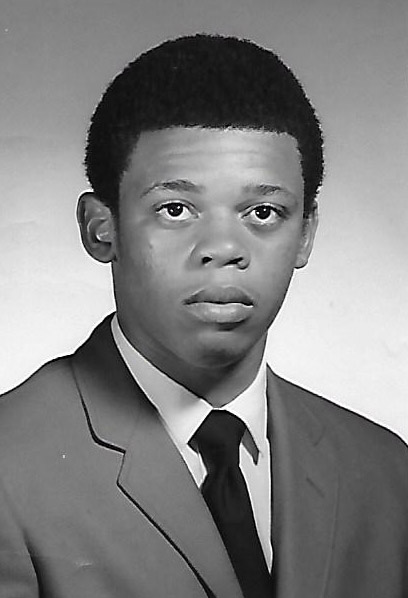 In his senior year, now as team captain, Coach Bob Commings placed him into the starting running back role and he was an immediate success. For the season, he rushed 253 times (4th all-time) for 1,395 yards (8th time), for an average of 5.5 yards per attempt. He also led the team in scoring with 102 points, including 14 touchdowns. For his performance he earned 1st Team All-Ohio honors.
In his senior year, now as team captain, Coach Bob Commings placed him into the starting running back role and he was an immediate success. For the season, he rushed 253 times (4th all-time) for 1,395 yards (8th time), for an average of 5.5 yards per attempt. He also led the team in scoring with 102 points, including 14 touchdowns. For his performance he earned 1st Team All-Ohio honors.
The team finished the regular season 10-0 and qualified for Ohio’s first-ever state playoffs, having won their respective region. Unfortunately, they dropped a 17-14 decision to Cincinnati Princeton. Eight times Hannon rushed over 100 yards, with a monster effort coming against Upper Arlington in a 14-0 victory. After UA captured consecutive state championships (1967-69) and the Tigers taking the crown in 1970, it was time to claim bragging rights once and for all with a game in Columbus. In front of an over-capacity crowd of 11,500 avid fans, Hannon rushed 24 times for 212 yards (8.8 yards/att.). Later, against Canton McKinley, Tommy rushed 22 times for 159 yards in a 12-3 win. Ironically, he didn’t score in either contest.
He also participated in basketball and track.
After high school, Hannon accepted a scholarship to play for Michigan State (1973-76), where he lined up at safety for four years. Twice he was named All-American and twice All-Big Ten. That culminated in a 9-year career with the Minnesota Vikings, where he started in 103 games and recorded fifteen pass interceptions.
In 1994, Hannon was inducted into the Massillon Wall of Champions.
Jerome Myricks (1985-87)
Jerome Myricks’ talent was recognized immediately and he suited up for the varsity as a sophomore. There, he returned kickoffs and received limited time at running back. In his junior year he became a regular player on both sides of the ball. As a running back, he rushed 53 times for 390 yards (7.1/att.) and scored 54 points. He was also a favored receiver, catching 13 for 262 yards (20.0/rec.) and scoring two touchdowns. Along with 17 tackle points, he continued his roles on special teams by returning six kickoffs (24.7/att.) and eight punts (9.0/att.).
 But the best was yet to come, when he was named 1st team All-Ohio during his senior year. For the season, the 5’-11, 181 lb. Myricks was the featured rusher, carrying the ball 175 times for 1,170 yards at 6.5 yards per attempt. He also caught 12 passes for 255 yards (21.3/rec.). Fifteen touchdowns came on the ground, three in the air and one via a fumble return. On defense he recorded 91 tackle points and still found some time to return a few kickoffs and punts.
But the best was yet to come, when he was named 1st team All-Ohio during his senior year. For the season, the 5’-11, 181 lb. Myricks was the featured rusher, carrying the ball 175 times for 1,170 yards at 6.5 yards per attempt. He also caught 12 passes for 255 yards (21.3/rec.). Fifteen touchdowns came on the ground, three in the air and one via a fumble return. On defense he recorded 91 tackle points and still found some time to return a few kickoffs and punts.
His most memorable games were as follows:
- Altoona, PA – 2 touchdown receptions of 50 and 60 yards.
- Canton GlenOak – Rushed 21 times for 161 yards and 2 touchdowns.
- Barberton – Rushed 10 times for 190 yards; scored on runs of 34, 43 and 54 yards.
- Austintown Fitch – Rushed 25 times for 119 yards and scored 3 touchdowns.
- Akron St. Vincent – Scored 3 touchdowns: 2 rushing and 1 receiving.
- Canton McKinley – Rushed 20 times for 145 yards; scored twice, including one of 50 yards in an 18-15 loss.
Travis McGuire (1990-91)
Long-time Tiger fans will remember Travis McGuire as the running back that in 1991 gained 302 yards (2nd all-time) and scored five touchdowns (5th all-time) against Canton McKinley in a 42-13 blowout victory. But he was more than that. A man among boys, he was the main focus every week. And he was good enough to earn 1st Team All-Ohio and Division 1 Back of the Year honors during his senior season. Good enough to set rushing marks that weren’t broken for fifty years. And good enough to receive a full scholarship to play for Ohio State.
 McGuire entered varsity play during his junior year and had a respectable season, playing under Head Coach Lee Owens. He rushed 96 times for 535 yards at 5.3 yard per carry and scored five touchdowns. He also caught twelve passes.
McGuire entered varsity play during his junior year and had a respectable season, playing under Head Coach Lee Owens. He rushed 96 times for 535 yards at 5.3 yard per carry and scored five touchdowns. He also caught twelve passes.
But his senior year was simply memorable. Now as team captain, he paired up with running mate Falando Ashcraft to propel the Tigers to the state semifinal playoff game against eventual state champion Cleveland St. Ignatius, losing the match by just a single point. For the season he carried the ball 251 times (5th all-time) for 1,976 yards (2nd all-time) and scored 26 touchdowns (3rd all-time). He also averaged a current Massillon-best 152 yards per game. In addition, he caught 19 passes for 170 yards (8.9/rec.) and two touchdowns.
The following are his highlight games for that year:
- Akron Garfield – Rushed 11 times for 132 yards (12.0/att.) and scored 2 touchdowns.
- Toledo St. Francis – Rushed 23 times for 187 yards and scored one touchdown.
- Youngstown East – Rushed 9 times for 157 yards and scored 3 touchdowns. The 17.4 yards per carry is 2nd all-time.
- Canton McKinley – Rushed 36 times for 302 yards (8.4/att.) and scored 5 touchdowns.
- Akron Ellet – Rushed 19 times for 198 yards (10.4/att.) and scored twice.
- Toledo St. John’s (8-3) – Rushed 29 times for 229 yards (7.9/att.) and scored 3 touchdowns.
- Cleveland St. Ignatius (12-2) – Rushed 24 times for 118 yards.
For his career, McGuire rushed 346 times for 2,511 yards (5th all-time) and scored 30 touchdowns, averaging 7.3 yards per carry.
Following high school, he accepted a scholarship to play for Ohio State. But injuries there curtailed his career. Currently, Travis is the running backs coach for the Massillon Tigers.
Falando Ashcraft (1989-91)
Falando Ashcraft teamed with Travis McGuire to create one of the more potent dual running back combinations that Massillon has ever had. While McGuire surely dominated during the 1991 season, it was Ashcraft who carried the load the previous year. Not that Falando himself didn’t have an equally good, if not better, senior year.
 As a sophomore, Ashcraft saw limited time at running back and also return kickoffs. He rushed 51 times for 259 yards (5.0/att.) and scored three touchdowns. During his junior year he moved into the starting running back position, where he rushed 202 times for 1,182 yards (5.9/att.) and scored 14 rushing touchdowns, totaling a team-high 86 points. His feature games were as follows:
As a sophomore, Ashcraft saw limited time at running back and also return kickoffs. He rushed 51 times for 259 yards (5.0/att.) and scored three touchdowns. During his junior year he moved into the starting running back position, where he rushed 202 times for 1,182 yards (5.9/att.) and scored 14 rushing touchdowns, totaling a team-high 86 points. His feature games were as follows:
- Covington Catholic, KY – 28 carries for 190 yards and one touchdown in the Buddy LaRosa Classic held in Cincinnati. Named Most Valuable Player.
- Nordonia – Scored 3 touchdowns in only 4 carries.
- Youngstown East – 11 carries for 142 yards and 3 touchdowns.
Ashcraft’s senior year was his best, when he rushed 208 times for 1,353 yards (6.4/att.) and scored 21 rushing touchdowns and one TD receiving, totaling 140 points. In eight of the 13 games he eclipsed the 100-yard rushing mark. The team that year qualified for the playoffs and advanced to the state semifinal game where they lost in the last minute to Cleveland St. Ignatius, 14-13. His best games were:
- Austintown Fitch – 25 carries for 214 yards and 2 touchdowns.
- Toledo St. Francis – 27 carries for 160 yards and 2 touchdowns.
- Youngstown East – 15 carries for 128 yards and 4 touchdowns; also caught a touchdown pass.
- Toledo St. John’s – 18 carries for 165 yards and 3 touchdowns.
Following the season Ashcraft was awarded Honorable Mention All-Ohio. But he should have been higher, while presumably playing in the shadow of Travis McGuire.
For his career, Falando is all-time 4th place in the record book in three different categories: attempts (461), yards (2,794) and touchdowns rushing (22). He is also 5th in career touchdowns (38).
Brian Gamble (2005-06)
Brian Gamble was one of the few players that could literally take over a game. And he was a game-changer, as evidenced by his heroics at the end of the 2005 Division 1 state finals contest against Lakewood St. Edward. In that one, in the last five minutes of the game, he scored two touchdowns and converted a 3rd down and 30 to pull out a 21-17 victory.
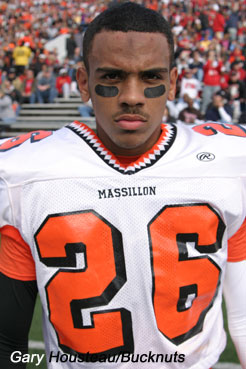 As a junior, Gamble helped his team to a 13-2 record and a spot in the state finals. He was also a team captain. For the season, he rushed 248 times (6th all-time) for 1,512 yards (5th all-time) and scored 17 touchdowns. He was also a prolific receiver, catching 32 passes for 631 yards and four touchdowns. But Brian also lined up on the other side of the ball as a defensive back. During the season he recorded 75 tackle points (2nd on the team), including eight tackles-for-loss and intercepted three passes. After the season he was named 1st Team All-Ohio.
As a junior, Gamble helped his team to a 13-2 record and a spot in the state finals. He was also a team captain. For the season, he rushed 248 times (6th all-time) for 1,512 yards (5th all-time) and scored 17 touchdowns. He was also a prolific receiver, catching 32 passes for 631 yards and four touchdowns. But Brian also lined up on the other side of the ball as a defensive back. During the season he recorded 75 tackle points (2nd on the team), including eight tackles-for-loss and intercepted three passes. After the season he was named 1st Team All-Ohio.
He most memorable games were as follows:
- Dover – Carried the ball 14 times for 164 yards (11.7/att.).
- Cincinnati Elder – 15 carries for 173 yards and 2 touchdowns, including one from 50 yards out in a 35-31 victory.
- Cleveland St. Ignatius – Carried the ball 31 times for 133 yards and one touchdown; caught 4 passes for 67 yards and one touchdown; won 29-26.
- North Canton – 14 attempts for 146 yards (10.4/att.) and a touchdown run of 80 yards; 3 pass receptions for 70 yards and a touchdown reception of 54 yards.
- Lakewood St. Edward (12-1) – Scored the last two touchdowns of the game to erase a 17-7 deficit and win 21-17; touchdown reception of 18 yards and touchdown reception of 5 yards (with 1:56 remaining in the game).
As a senior, the Tigers were not nearly as talented, but they still managed to make the playoffs, with Gamble again having a productive year. He rushed 215 times for 975 yards and scored nine touchdowns. On defense he recorded 38 tackle points and had three pass interceptions. His biggest game came against Hamilton Chandler, when he rushed 35 times for 167 yards and one TD and caught four passes for 44 yards and two scores. Chandler went on to finish 9-1 and capture the Arizona state championship.
For his career, Gamble rushed 463 times (3rd all-time) for 2,487 yards (7th all-time) and scored 36 touchdowns (7th all-time).
Following high school, he played a year for the University of Illinois at wide receiver. The Illini finished second in the Big 10 that year behind Ohio State, but did knock off the Buckeyes 28-21, with Gamble catching a touchdown pass that gave his team the lead for good. Later, he transferred to Ashland University where he finished his career as a defensive back under former Tiger Mentor Lee Owens.
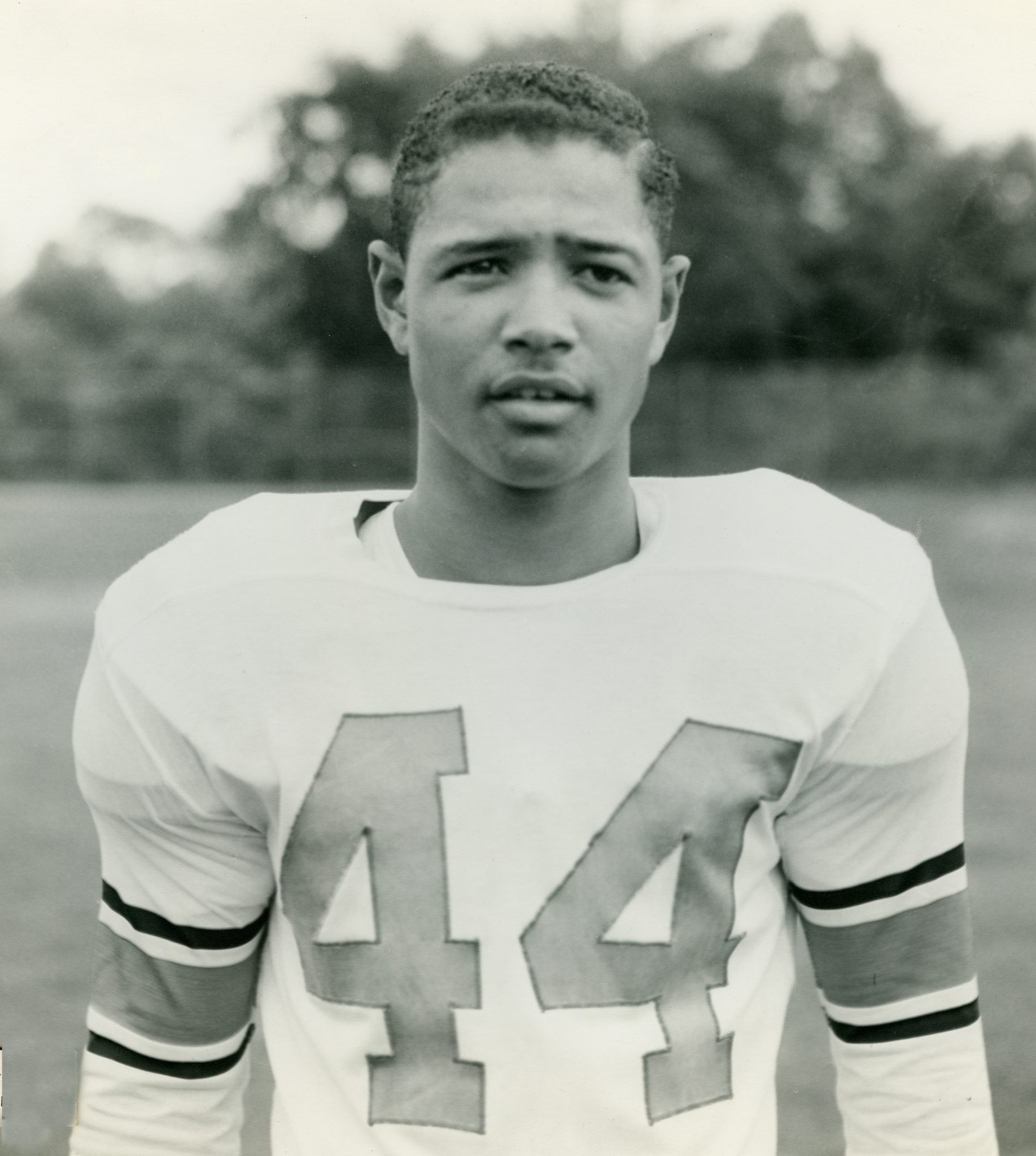
 The following year Crable was “the man.” Leading his team to a 9-1 record and a state championship, he again led the team in scoring, this time with 114 points, including 18 rushing touchdowns and a 60-yard pass interception return against Toledo Waite. He also passed for a TD. Three times he scored three touchdowns in a single game, against Canton Lincoln (60-0), Alliance (48-14) and Waite (59-19). For the season, he carried the ball 100 times for 1,129 yards, setting a record for single season average yards per rush at 11.3, a benchmark that stands today.
The following year Crable was “the man.” Leading his team to a 9-1 record and a state championship, he again led the team in scoring, this time with 114 points, including 18 rushing touchdowns and a 60-yard pass interception return against Toledo Waite. He also passed for a TD. Three times he scored three touchdowns in a single game, against Canton Lincoln (60-0), Alliance (48-14) and Waite (59-19). For the season, he carried the ball 100 times for 1,129 yards, setting a record for single season average yards per rush at 11.3, a benchmark that stands today. After sitting out for his junior year due to an injury, he joined the varsity the following season, playing at 5’-9”, 155 lbs. and being selected as a co-captain. His primary position was right halfback, where he became the second leading scorer with 54 points, behind Ivory Benjamin, who had 90. That included seven rushing touchdowns, six PATs and a 79-yard kickoff return for a score against Canton Lincoln. Two of his rushing touchdowns came against
After sitting out for his junior year due to an injury, he joined the varsity the following season, playing at 5’-9”, 155 lbs. and being selected as a co-captain. His primary position was right halfback, where he became the second leading scorer with 54 points, behind Ivory Benjamin, who had 90. That included seven rushing touchdowns, six PATs and a 79-yard kickoff return for a score against Canton Lincoln. Two of his rushing touchdowns came against  Benjamin was limited to a single carry and a couple of punt returns as a sophomore, but at least he got his feet wet, while the team went 8-1-1 and finished second in the state. But the following year he became a full-time starter at running back and led the Tigers in both scoring (72 points) and rushing. Included in that was 12 rushing touchdowns (3 vs. Barberton), one receiving TD and two long punt returns for scores (50 yards vs. Cleveland Benedictine and 65 yards vs. Warren Harding.) The Team finished 8-2 and again finished second in the state.
Benjamin was limited to a single carry and a couple of punt returns as a sophomore, but at least he got his feet wet, while the team went 8-1-1 and finished second in the state. But the following year he became a full-time starter at running back and led the Tigers in both scoring (72 points) and rushing. Included in that was 12 rushing touchdowns (3 vs. Barberton), one receiving TD and two long punt returns for scores (50 yards vs. Cleveland Benedictine and 65 yards vs. Warren Harding.) The Team finished 8-2 and again finished second in the state. Hastings saw limited varsity action during his sophomore year, although he did score a touchdown in Week 8 in a win over Barberton. But in his junior season he took over for the graduating senior Dave Dean and became the primary ball carrier on a 10-0 team that captured both the state and national championships. For the season he carried the ball 117 times for 1,245 yards (10.6) average and scored 12 rushing touchdowns. He also returned punts and kickoffs. At the end of the season Hastings was named 3rd Team All-Ohio (should have been 1st Team with those numbers; such is the life of an underclassman). Record-wise, he holds third place for the best single season rushing yards per attempt and third best for career consecutive 100+ yard games with seven.
Hastings saw limited varsity action during his sophomore year, although he did score a touchdown in Week 8 in a win over Barberton. But in his junior season he took over for the graduating senior Dave Dean and became the primary ball carrier on a 10-0 team that captured both the state and national championships. For the season he carried the ball 117 times for 1,245 yards (10.6) average and scored 12 rushing touchdowns. He also returned punts and kickoffs. At the end of the season Hastings was named 3rd Team All-Ohio (should have been 1st Team with those numbers; such is the life of an underclassman). Record-wise, he holds third place for the best single season rushing yards per attempt and third best for career consecutive 100+ yard games with seven.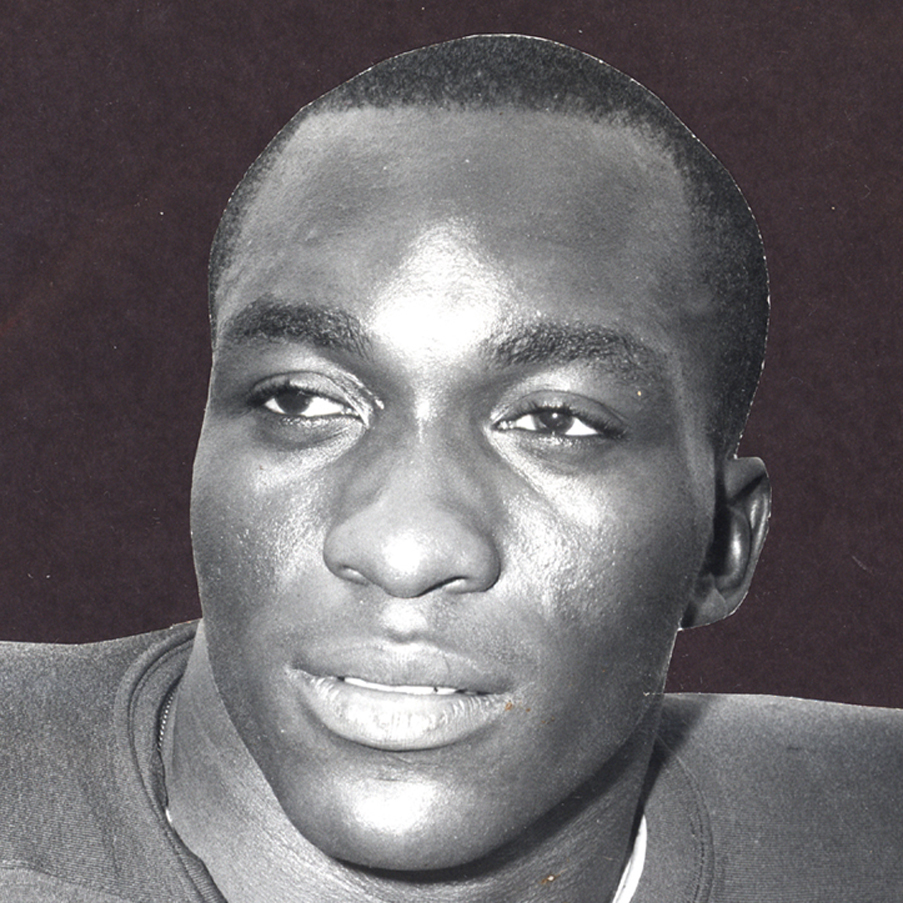 But he was ready to go as a senior and eclipsed the 1,000-yard mark as running back, leading his team to a UPI state championship and a national championship with an 11-0 record. He rushed 175 times for 1,094 yards (6.3 ave.) and scored eleven rushing touchdowns. Three came against Warren Harding in a 36-0 victory and two each came against Steubenville (7-3) and Toledo Libbey.
But he was ready to go as a senior and eclipsed the 1,000-yard mark as running back, leading his team to a UPI state championship and a national championship with an 11-0 record. He rushed 175 times for 1,094 yards (6.3 ave.) and scored eleven rushing touchdowns. Three came against Warren Harding in a 36-0 victory and two each came against Steubenville (7-3) and Toledo Libbey.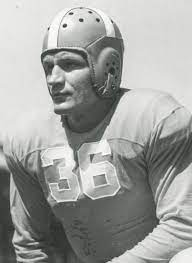
 Not a lot is known about Stanfield Wells’ time at Massillon, other than he played one year for the Tigers, at left halfback and teamed with his twin brother, Guy, who was on the line. That, after the family had moved in from far away South Dakota. The team was not stellar, finishing 1-5. But after Massillon he played collegiately for the
Not a lot is known about Stanfield Wells’ time at Massillon, other than he played one year for the Tigers, at left halfback and teamed with his twin brother, Guy, who was on the line. That, after the family had moved in from far away South Dakota. The team was not stellar, finishing 1-5. But after Massillon he played collegiately for the 
 Henry Krier played running back during Coach Paul Brown’s first three seasons at Massillon. In 1933 the team finished 8-2, with Krier contributing 12 touchdowns, 11 rushing and one via an interception return. He also kicked 17 points after touchdown.
Henry Krier played running back during Coach Paul Brown’s first three seasons at Massillon. In 1933 the team finished 8-2, with Krier contributing 12 touchdowns, 11 rushing and one via an interception return. He also kicked 17 points after touchdown.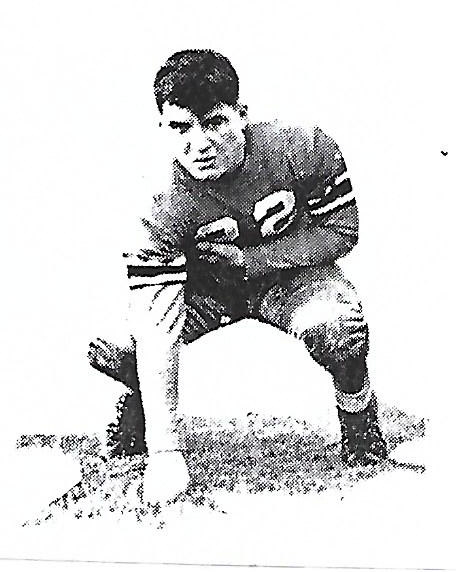
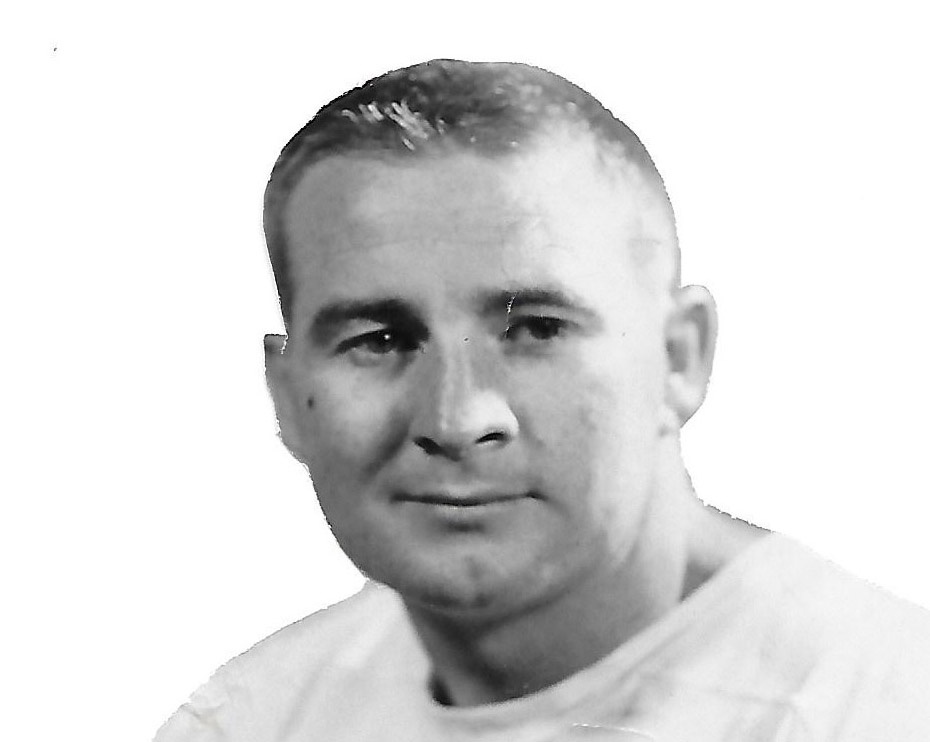 Tommy James never lost a game during his three years at Massillon, with his teams going 30-0 and winning the state title each year. They also won two national titles. All under Head Coach Paul Brown.
Tommy James never lost a game during his three years at Massillon, with his teams going 30-0 and winning the state title each year. They also won two national titles. All under Head Coach Paul Brown. Pokey Blunt was able to experience three state championships and two national champions enroute to a 29-0-1 overall record. He scored nine touchdowns during his junior year, including three against Cleveland Cathedral Latin in a 39-0 victory.
Pokey Blunt was able to experience three state championships and two national champions enroute to a 29-0-1 overall record. He scored nine touchdowns during his junior year, including three against Cleveland Cathedral Latin in a 39-0 victory.
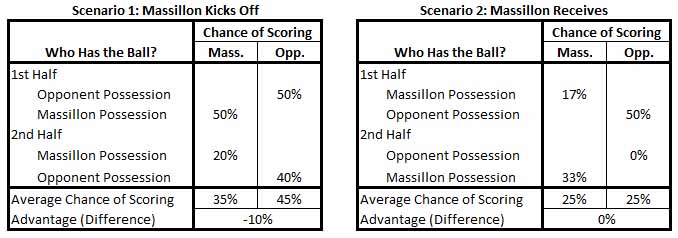
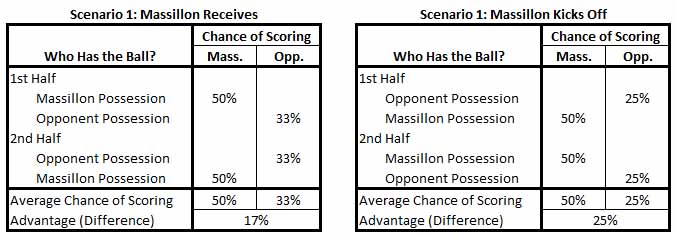

 Larsuel began his varsity career in 1962 as a 5’-8”, 176 lb. sophomore when
Larsuel began his varsity career in 1962 as a 5’-8”, 176 lb. sophomore when 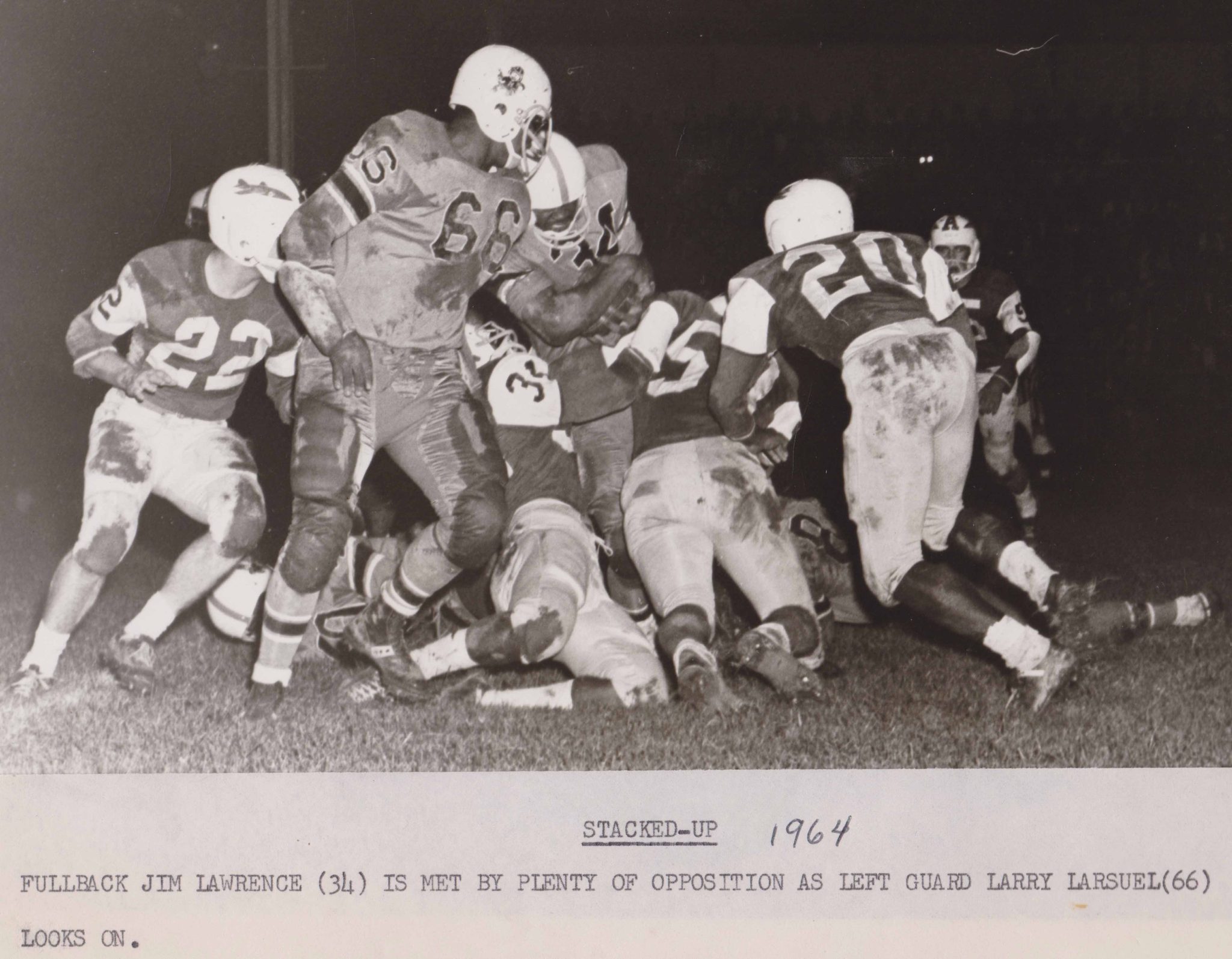 “THEY OWNED US down the middle in the second half,” said Altoona Coach Earl Strohm, headman of the Lions, now in his 11th year at the Pennsylvania football power house. The veteran coach was especially impressed with Larsuel, terming the senior all-county and all-state guard “a real good football player.” Based on the game movies, fullback Lawrence was named player of the week for his running and faking. Lineman of the week was guard Tom Whitfield with Larsuel the runner-up. — Massillon Evening Independent.
“THEY OWNED US down the middle in the second half,” said Altoona Coach Earl Strohm, headman of the Lions, now in his 11th year at the Pennsylvania football power house. The veteran coach was especially impressed with Larsuel, terming the senior all-county and all-state guard “a real good football player.” Based on the game movies, fullback Lawrence was named player of the week for his running and faking. Lineman of the week was guard Tom Whitfield with Larsuel the runner-up. — Massillon Evening Independent.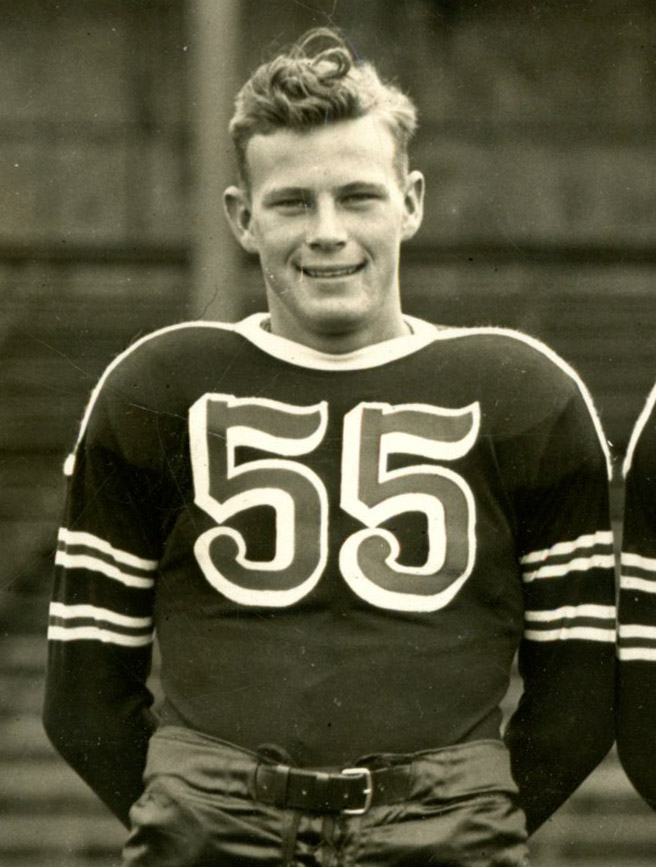
 In 1993 during his junior year Spencer became a varsity starter at defensive back and was part of a team that compiled a 10-2 record, while losing in the playoff regionals. With an uncanny ability quickly break for the ball, he had six pass interceptions, three of which were returned for touchdowns, including 87 yards against Grove City, PA, 54 yards against Austintown Fitch and 36 yards against Akron St. Vincent. He also recovered two fumbles, returning one for a score. In addition, he was the backup quarterback, where he scored one rushing touchdown.
In 1993 during his junior year Spencer became a varsity starter at defensive back and was part of a team that compiled a 10-2 record, while losing in the playoff regionals. With an uncanny ability quickly break for the ball, he had six pass interceptions, three of which were returned for touchdowns, including 87 yards against Grove City, PA, 54 yards against Austintown Fitch and 36 yards against Akron St. Vincent. He also recovered two fumbles, returning one for a score. In addition, he was the backup quarterback, where he scored one rushing touchdown. The following year it all came together and with just Franklin at the QB position the team exploded with an undefeated 10-0 season. Massillon led the All-American Conference in both rushing and passing and outscored its opposition 412-29. In a key Week 4 matchup with state-ranked Niles, Franklin led his team to a 22-3 comeback victory. He also scored all three touchdowns in a 22-0 win over Warren Harding and was involved in four TDs against Trotwood Madison. The magical season was then punctuated by a 28-0 victory over previously undefeated and state No. 3 Canton McKinley.
The following year it all came together and with just Franklin at the QB position the team exploded with an undefeated 10-0 season. Massillon led the All-American Conference in both rushing and passing and outscored its opposition 412-29. In a key Week 4 matchup with state-ranked Niles, Franklin led his team to a 22-3 comeback victory. He also scored all three touchdowns in a 22-0 win over Warren Harding and was involved in four TDs against Trotwood Madison. The magical season was then punctuated by a 28-0 victory over previously undefeated and state No. 3 Canton McKinley.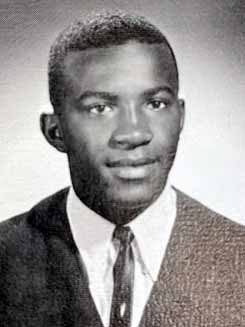 The following year, Sheegog was the starter and he help the Tigers to a consecutive unbeaten season and another state title. His key games included:
The following year, Sheegog was the starter and he help the Tigers to a consecutive unbeaten season and another state title. His key games included: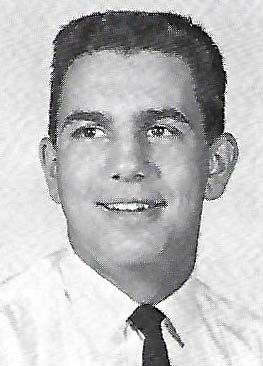 Joe had the long arm desired by most quarterbacks. It was so long that he eventually made a career of throwing fastballs for the
Joe had the long arm desired by most quarterbacks. It was so long that he eventually made a career of throwing fastballs for the 
 As a sophomore he completed 111 of 205 (54%) passes for 1,643 yards and 14 touchdowns in helping his team to a 7-3 regular season mark and a birth in the state playoffs.
As a sophomore he completed 111 of 205 (54%) passes for 1,643 yards and 14 touchdowns in helping his team to a 7-3 regular season mark and a birth in the state playoffs. After a modest beginning as a sophomore, Huth became the starter in 2005, completing 141 of 223 passes (63.2%) for 2,017 yards and 18 touchdowns in leading his team to the Division 1 state finals. Huth was a part of many significant victories that year, including the following:
After a modest beginning as a sophomore, Huth became the starter in 2005, completing 141 of 223 passes (63.2%) for 2,017 yards and 18 touchdowns in leading his team to the Division 1 state finals. Huth was a part of many significant victories that year, including the following: “Ruby” Ertle played both linebacker and lineman under
“Ruby” Ertle played both linebacker and lineman under 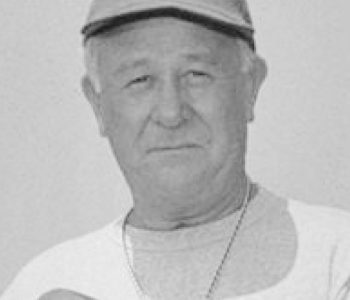
 In
In 
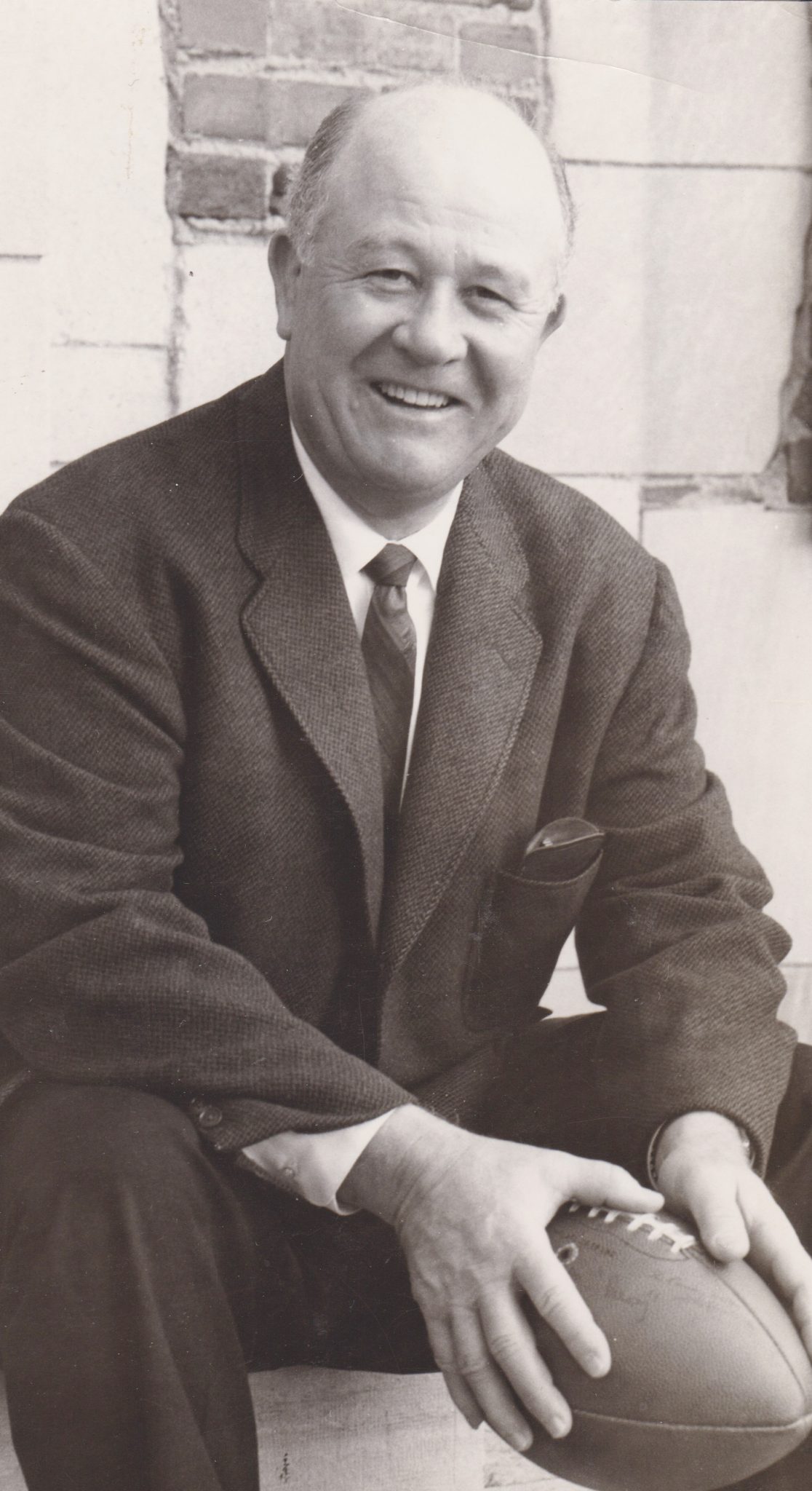 Springfield High School (1931) – Assistant coach and history teacher.
Springfield High School (1931) – Assistant coach and history teacher.